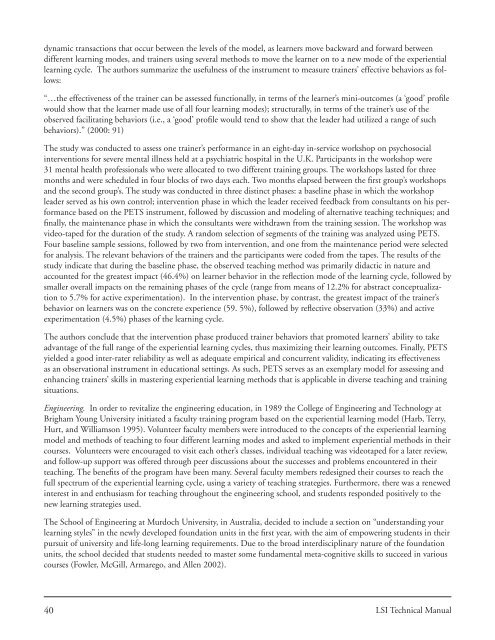The Kolb Learning Style Inventory—Version 3.1 2005 - Whitewater ...
The Kolb Learning Style Inventory—Version 3.1 2005 - Whitewater ...
The Kolb Learning Style Inventory—Version 3.1 2005 - Whitewater ...
You also want an ePaper? Increase the reach of your titles
YUMPU automatically turns print PDFs into web optimized ePapers that Google loves.
dynamic transactions that occur between the levels of the model, as learners move backward and forward between<br />
different learning modes, and trainers using several methods to move the learner on to a new mode of the experiential<br />
learning cycle. <strong>The</strong> authors summarize the usefulness of the instrument to measure trainers’ effective behaviors as follows:<br />
“…the effectiveness of the trainer can be assessed functionally, in terms of the learner’s mini-outcomes (a ‘good’ profi le<br />
would show that the learner made use of all four learning modes); structurally, in terms of the trainer’s use of the<br />
observed facilitating behaviors (i.e., a ‘good’ profi le would tend to show that the leader had utilized a range of such<br />
behaviors).” (2000: 91)<br />
<strong>The</strong> study was conducted to assess one trainer’s performance in an eight-day in-service workshop on psychosocial<br />
interventions for severe mental illness held at a psychiatric hospital in the U.K. Participants in the workshop were<br />
31 mental health professionals who were allocated to two different training groups. <strong>The</strong> workshops lasted for three<br />
months and were scheduled in four blocks of two days each. Two months elapsed between the fi rst group’s workshops<br />
and the second group’s. <strong>The</strong> study was conducted in three distinct phases: a baseline phase in which the workshop<br />
leader served as his own control; intervention phase in which the leader received feedback from consultants on his performance<br />
based on the PETS instrument, followed by discussion and modeling of alternative teaching techniques; and<br />
fi nally, the maintenance phase in which the consultants were withdrawn from the training session. <strong>The</strong> workshop was<br />
video-taped for the duration of the study. A random selection of segments of the training was analyzed using PETS.<br />
Four baseline sample sessions, followed by two from intervention, and one from the maintenance period were selected<br />
for analysis. <strong>The</strong> relevant behaviors of the trainers and the participants were coded from the tapes. <strong>The</strong> results of the<br />
study indicate that during the baseline phase, the observed teaching method was primarily didactic in nature and<br />
accounted for the greatest impact (46.4%) on learner behavior in the refl ection mode of the learning cycle, followed by<br />
smaller overall impacts on the remaining phases of the cycle (range from means of 12.2% for abstract conceptualization<br />
to 5.7% for active experimentation). In the intervention phase, by contrast, the greatest impact of the trainer’s<br />
behavior on learners was on the concrete experience (59. 5%), followed by refl ective observation (33%) and active<br />
experimentation (4.5%) phases of the learning cycle.<br />
<strong>The</strong> authors conclude that the intervention phase produced trainer behaviors that promoted learners’ ability to take<br />
advantage of the full range of the experiential learning cycles, thus maximizing their learning outcomes. Finally, PETS<br />
yielded a good inter-rater reliability as well as adequate empirical and concurrent validity, indicating its effectiveness<br />
as an observational instrument in educational settings. As such, PETS serves as an exemplary model for assessing and<br />
enhancing trainers’ skills in mastering experiential learning methods that is applicable in diverse teaching and training<br />
situations.<br />
Engineering. In order to revitalize the engineering education, in 1989 the College of Engineering and Technology at<br />
Brigham Young University initiated a faculty training program based on the experiential learning model (Harb, Terry,<br />
Hurt, and Williamson 1995). Volunteer faculty members were introduced to the concepts of the experiential learning<br />
model and methods of teaching to four different learning modes and asked to implement experiential methods in their<br />
courses. Volunteers were encouraged to visit each other’s classes, individual teaching was videotaped for a later review,<br />
and follow-up support was offered through peer discussions about the successes and problems encountered in their<br />
teaching. <strong>The</strong> benefi ts of the program have been many. Several faculty members redesigned their courses to reach the<br />
full spectrum of the experiential learning cycle, using a variety of teaching strategies. Furthermore, there was a renewed<br />
interest in and enthusiasm for teaching throughout the engineering school, and students responded positively to the<br />
new learning strategies used.<br />
<strong>The</strong> School of Engineering at Murdoch University, in Australia, decided to include a section on “understanding your<br />
learning styles” in the newly developed foundation units in the fi rst year, with the aim of empowering students in their<br />
pursuit of university and life-long learning requirements. Due to the broad interdisciplinary nature of the foundation<br />
units, the school decided that students needed to master some fundamental meta-cognitive skills to succeed in various<br />
courses (Fowler, McGill, Armarego, and Allen 2002).<br />
40 LSI Technical Manual


